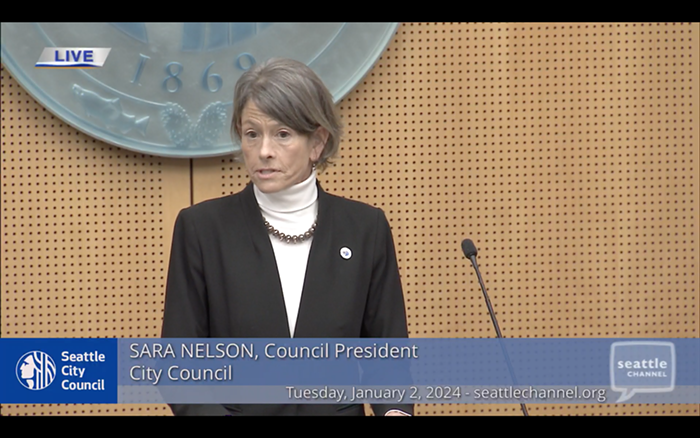By any standard, the Old Seattle Parking Garage is unexceptional. The squat greenish-gray building at 316 Alaskan Way has little to offer visually and even less historical significance.
"Although the building has served as a garage since 1919," reads a Seattle Department of Neighborhoods summary of its history, "in general it does not appear to be associated with specific historic events or significant people."
A long time ago, the garage probably wore the same warm-hued brick of so many other Pioneer Square buildings, but it has since been stuccoed over, according to city documents. Today, it's a boring gray box darkened by the shadow of the crumbling viaduct.
Yet, thanks to a months-long fight between Pioneer Square neighbors and developers, the unexceptional garage has been temporarily saved. Late last month, a group of Pioneer Square neighbors successfully halted the development of an 11-story, 200-unit market-rate apartment building on the site of the nearly century-old garage. The neighbors aren't explicitly arguing for the garage, but on a block of mostly four- and five-story buildings, they say the proposed building wouldn't fit the "character" of Pioneer Square.
Cindy Aden, who lives next door to the garage with her husband in a 900-square-foot condo with 14-foot ceilings and exposed brick, says residents in her building "would love" an apartment building next door. "It just has to be built appropriately," she says. "No one is saying the garage has to stay."
But, for now, the garage will stay. In today's Seattle—where rents and homelessness are high, working people are rapidly being pushed out of the city, and environmentalists acknowledge that density is one way to combat climate change—bigger buildings must go somewhere. One place larger buildings can't go: the 65 percent of the city that is zoned single-family (that number includes parks and open space). Last year, the mayor's Housing Affordability and Livability Agenda (HALA) Committee called that 65 percent "no longer either realistic or sustainable," but homeowner backlash means it's unlikely to change anytime soon.
So areas of the city already zoned for more density—areas like downtown and Pioneer Square—will have to accept bigger buildings and more residents. And that, inevitably, will mean new, taller buildings next to old, shorter buildings. That inconsistency in height isn't an unusual sight in many cities all over America or even in other Seattle neighborhoods. Urbanists say the entire city should be willing to accept some of this kind of growth; preservationists say Pioneer Square is different and new housing should "fit in." With the pressure of another 120,000 people expected to move to the city in the next 20 years, those concerns about "neighborhood character" could slow much-needed growth—and further drive up housing costs.
The Pioneer Square area in question was up-zoned in 2011 to allow for buildings up to 120 feet—about 11 to 12 stories—but because of Pioneer Square's historic designation, projects there are also subject to special regulations. Those include review from the Pioneer Square Preservation Board, a 10-member citizen group.
Last year, the board rejected the project, only to be overturned by the city's Department of Neighborhoods director, Kathy Nyland. Then, in late February, the city's deputy hearing examiner reversed Nyland's decision, saying the scale of the building must be considered along with its height and this proposal was simply too big. That has killed the project for now. (The developer, who didn't return requests for comment, could appeal the decision.)
The Adens insist they aren't NIMBYs—they aren't concerned about parking, traffic, transients—and would gladly welcome 200 new apartments next door if the building looked different. At the maximum-allowed height, though, it's hard to imagine what they might be willing to accept.
"Maybe a creative architect will [design] a tower and they'll have a lower building and visually it will look whimsical and charming and it'll be in red brick and everyone will say, 'Oh this is cool. This is a great entrance to the waterway.' You know, maybe," Cindy Aden says. But, she adds, "We can't possibly weigh in."
The proposal for this new apartment building "was like a mushroom cloud," says Art Skolnik, a former state historic preservation officer who was involved with preservation of Pioneer Square in the 1970s. "This got everybody's attention." I ask him whether, considering rising housing costs and the environmental need for more density, he believes there's any validity to the idea that Seattle is changing and Pioneer Square must change along with it.
"Once you do that," he says, "you might as well tear it all down."
No one is talking about tearing it all down—just a parking garage—but we do need to talk about what can be built up. Right now, thanks to bodies like the Pioneer Square Preservation Board, building housing in areas where planning documents specifically call for more housing can be unpredictable and expensive.
Last year, the HALA Committee, whose recommendations will shape the next phase of Seattle's housing policy, called out the historic preservation review process as partially to blame for high housing costs. If improvements were made to the way the city does permitting, including streamlining the historic review process, HALA members wrote, the total timeline for some multifamily developments could be reduced by two months "and cost savings could total up to $4,000 per housing unit."
Alan Durning, executive director of the sustainability think tank the Sightline Institute and a member of the HALA Committee, says he supports some historic designations. "The danger," he says, "is when those processes become a blanket barrier to development to try to freeze those neighborhoods in amber."
Cindy Aden wants the exact opposite of HALA's recommendation: more design review.
"None of us should accept this," Aden says. "There are ways to build attractive neighborhoods that don't have to be so odious that no one is happy about it... It requires more citizen input. It requires that this process be slower and therefore probably more costly, but the result is something that has community buy-in."
For now, it's a draw: A victory for preservationists in one column, a city hall eager to implement HALA's recommendations in the other. Looking ahead, it's unclear just how willing preservationists will be to compromise—and how much they'll cost the rest of us in the meantime.
"We're in the middle of a generational change in land-use policy in Seattle," Durning says. "I think each of these fights... will be another battle in that giant war."



















